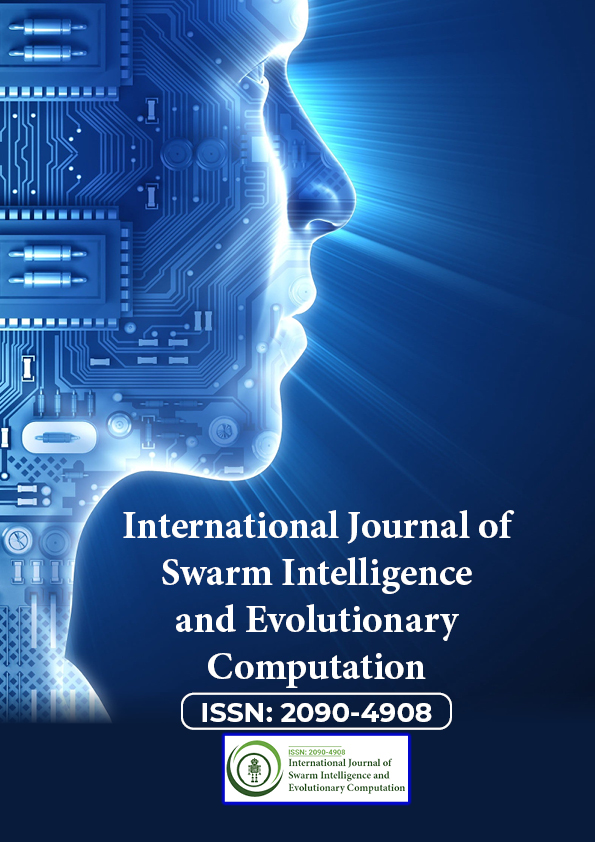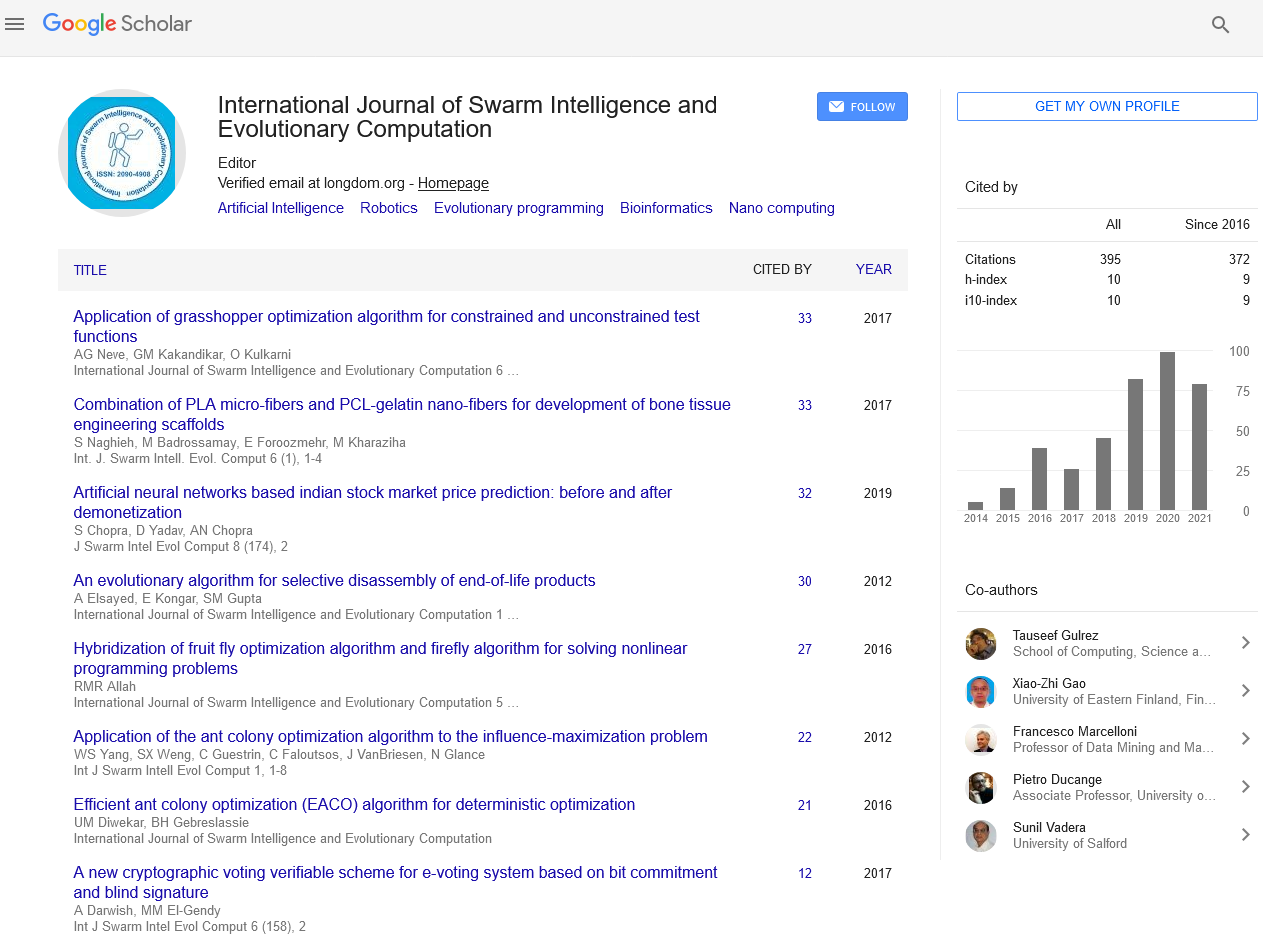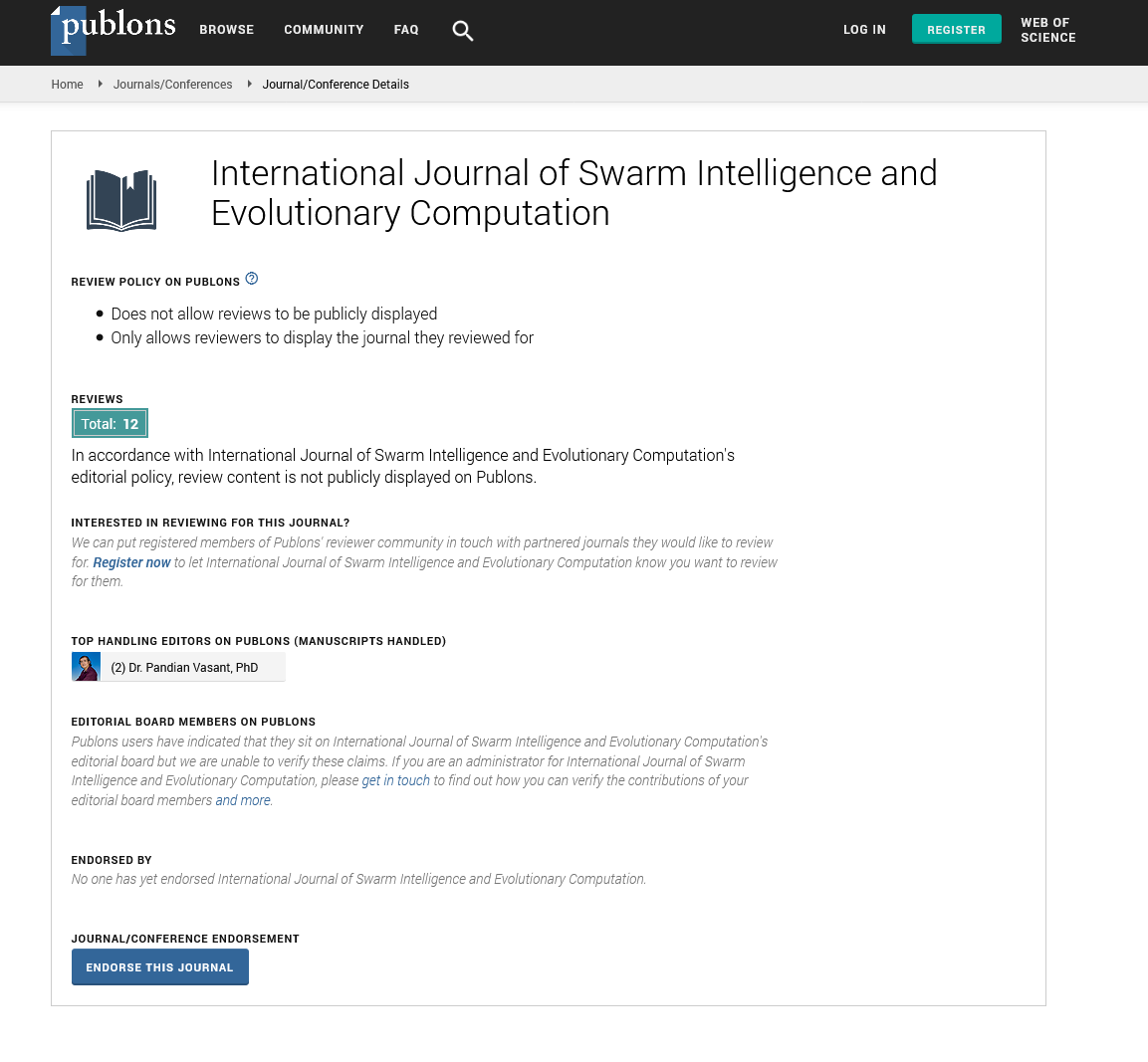Indexed In
- Genamics JournalSeek
- RefSeek
- Hamdard University
- EBSCO A-Z
- OCLC- WorldCat
- Publons
- Euro Pub
- Google Scholar
Useful Links
Share This Page
Journal Flyer

Open Access Journals
- Agri and Aquaculture
- Biochemistry
- Bioinformatics & Systems Biology
- Business & Management
- Chemistry
- Clinical Sciences
- Engineering
- Food & Nutrition
- General Science
- Genetics & Molecular Biology
- Immunology & Microbiology
- Medical Sciences
- Neuroscience & Psychology
- Nursing & Health Care
- Pharmaceutical Sciences
Opinion Article - (2024) Volume 13, Issue 5
Implementing Self-Organizing Systems in Adaptive Network Protocols
Tomomew Bade*Received: 26-Aug-2024, Manuscript No. SIEC-24-27460; Editor assigned: 28-Jun-2024, Pre QC No. SIEC-24-27460 (PQ); Reviewed: 11-Sep-2024, QC No. SIEC-24-27460; Revised: 18-Sep-2024, Manuscript No. SIEC-24-27460 (R); Published: 25-Sep-2024, DOI: 10.35248/2090-4908.24.13.393
Description
Self-organizing systems, inspired by natural phenomena like flocking birds, ant colonies, and neural networks, have become a fundamental concept in the design and operation of modern networks. These systems exhibit decentralized control, adaptability, and robustness, making them highly suitable for dynamic and complex network environments. In networking, adaptive protocols powered by self-organizing principles are important for improving efficiency, scalability, and resilience to failures.
Role of self-organizing systems in networking
Self-organizing systems are characterized by their ability to autonomously form structures and adapt to changes in the environment without external guidance or centralized control. In the context of adaptive network protocols, this means that network devices (such as routers, sensors, or nodes) can communicate and adjust their behavior based on local interactions and feedback from their environment. The network, as a whole, evolves over time through the interactions of its individual components.
In traditional network protocols, such as TCP/IP, the behavior of the network is largely governed by fixed rules and centralized decision-making. While effective in stable, well-defined environments, these protocols struggle in more dynamic settings where network conditions fluctuate, such as in Mobile Ad Hoc Networks (MANETs), Wireless Sensor Networks (WSNs), and Internet of Things (IoT) systems. Self-organizing systems offer a more adaptive approach, where protocols can adjust in real-time based on local information and network conditions, providing greater efficiency and reliability in these dynamic environments.
Features of self-organizing network protocols
One of the core principles of self-organizing systems is decentralization. In network protocols, this means that devices do not rely on a central server or controller to make decisions.
Instead, devices communicate with one another and make local decisions based on the data they collect. This peer-to-peer interaction enhances the scalability and fault tolerance of the network, as there is no single point of failure.
Self-organizing protocols are highly adaptive, meaning they can respond in real-time to changing network conditions, such as node mobility, link failures, or varying traffic loads. This adaptability is essential in environments like MANETs, where nodes are mobile and the network topology changes frequently. For example, in routing protocols like Dynamic Source Routing (DSR) or Ad hoc On-Demand Distance Vector (AODV), each node can make routing decisions dynamically based on the current state of the network.
Self-organizing networks are inherently fault-tolerant because they do not depend on a central point of control. If a node or link fails, the network can automatically reconfigure itself using the remaining nodes, ensuring continued operation. This feature is especially important in different applications, such as military communications or disaster recovery networks, where network reliability is paramount.
Over time, self-organizing networks can optimize their performance through continuous learning and feedback. In adaptive protocols, nodes exchange information about their environment and adjust their behavior based on this shared knowledge. For example, in a wireless sensor network, nodes can adjust their transmission power or change communication channels to minimize interference and maximize network throughput.
Self-organizing systems scale well as the number of devices in the network increases. Since there is no need for centralized management, additional nodes can be added to the network without overwhelming the existing infrastructure. This scalability makes self-organizing systems highly suitable for large-scale networks like IoT, where millions of devices may be deployed.
Several network protocols have successfully implemented selforganizing principles to improve performance and adaptability.
In MANETs, nodes are mobile and the network topology is constantly changing. Traditional routing protocols often fail in such environments, but self-organizing protocols like AODV and DSR adapt dynamically. These protocols allow nodes to discover and maintain routes based on real-time information, ensuring efficient communication even in highly dynamic settings.
WSNs are often deployed in remote or hostile environments, where manual configuration is impractical. Self-organizing protocols like Low-Energy Adaptive Clustering Hierarchy (LEACH) optimize energy consumption by clustering sensor nodes and selecting cluster heads dynamically. This protocol allows the network to self-organize and optimize communication, extending the network’s lifetime and ensuring effective data collection.
Autonomic networking, inspired by the concept of autonomic computing, refers to networks that can manage and optimize themselves without human intervention. In these systems, selforganizing protocols adjust network parameters such as routing paths, congestion control and Quality of Service (QoS) based on network performance and traffic patterns. These systems enable networks to automatically adapt to traffic fluctuations, node failures and other dynamic conditions, improving both efficiency and reliability.
IoT devices often have limited resources and need to operate in dynamic environments where network topologies can change. Self-organizing protocols in IoT networks enable devices to communicate directly with each other without the need for a central controller. For example, Zigbee and LoRaWAN are examples of self-organizing protocols designed for low-power, wide-area networks that allow devices to self-configure and adapt to changing network conditions.
Self-organizing systems offer a promising approach to implementing adaptive and efficient network protocols. By decentralizing control, enabling real-time adaptability, and optimizing network performance based on local interactions, these systems improve the scalability, resilience and fault tolerance of modern networks. With applications in MANETs, WSNs, IoT, and autonomic networking, self-organizing protocols are poised to play a pivotal role in the future of communication networks. As technology advances, overcoming the challenges of complexity, security and scalability will ensure that these systems can handle even larger and more dynamic network environments.
Citation: Bade T (2024). Implementing Self-Organizing Systems in Adaptive Network Protocols. Int J Swarm Evol Comput. 13:393.
Copyright: © 2024 Bade T. This is an open-access article distributed under the terms of the Creative Commons Attribution License, which permits unrestricted use, distribution, and reproduction in any medium, provided the original author and source are credited.


